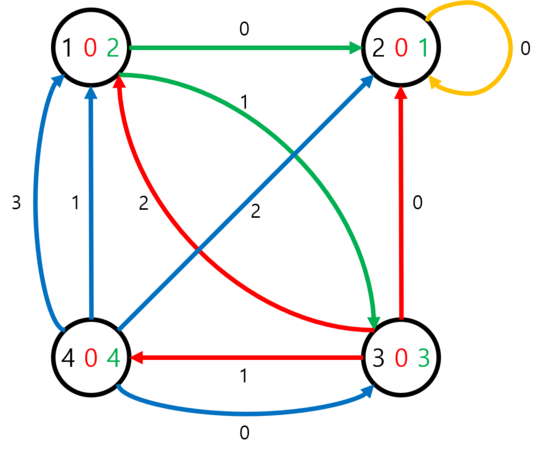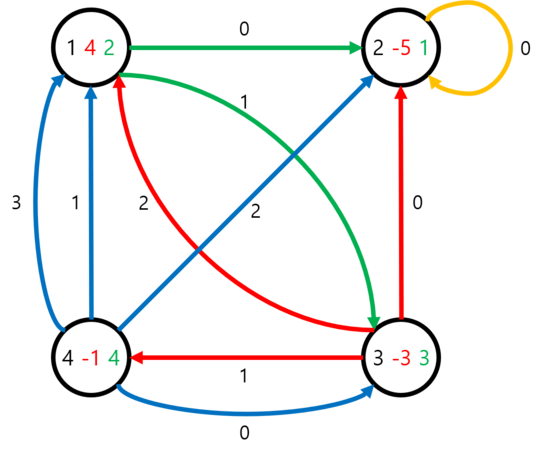CF1200F.Graph Traveler
普及/提高-
通过率:0%
AC君温馨提醒
该题目为【codeforces】题库的题目,您提交的代码将被提交至codeforces进行远程评测,并由ACGO抓取测评结果后进行展示。由于远程测评的测评机由其他平台提供,我们无法保证该服务的稳定性,若提交后无反应,请等待一段时间后再进行重试。
题目描述
Gildong is experimenting with an interesting machine Graph Traveler. In Graph Traveler, there is a directed graph consisting of n vertices numbered from 1 to n . The i -th vertex has mi outgoing edges that are labeled as ei[0] , ei[1] , … , ei[mi−1] , each representing the destination vertex of the edge. The graph can have multiple edges and self-loops. The i -th vertex also has an integer ki written on itself.
A travel on this graph works as follows.
- Gildong chooses a vertex to start from, and an integer to start with. Set the variable c to this integer.
- After arriving at the vertex i , or when Gildong begins the travel at some vertex i , add ki to c .
- The next vertex is ei[x] where x is an integer 0≤x≤mi−1 satisfying x≡c(modmi) . Go to the next vertex and go back to step 2.
It's obvious that a travel never ends, since the 2nd and the 3rd step will be repeated endlessly.
For example, assume that Gildong starts at vertex 1 with c=5 , and m1=2 , e1[0]=1 , e1[1]=2 , k1=−3 . Right after he starts at vertex 1 , c becomes 2 . Since the only integer x ( 0≤x≤1 ) where x≡c(modmi) is 0 , Gildong goes to vertex e1[0]=1 . After arriving at vertex 1 again, c becomes −1 . The only integer x satisfying the conditions is 1 , so he goes to vertex e1[1]=2 , and so on.
Since Gildong is quite inquisitive, he's going to ask you q queries. He wants to know how many distinct vertices will be visited infinitely many times, if he starts the travel from a certain vertex with a certain value of c . Note that you should not count the vertices that will be visited only finite times.
输入格式
The first line of the input contains an integer n ( 1≤n≤1000 ), the number of vertices in the graph.
The second line contains n integers. The i -th integer is ki ( −109≤ki≤109 ), the integer written on the i -th vertex.
Next 2⋅n lines describe the edges of each vertex. The (2⋅i+1) -st line contains an integer mi ( 1≤mi≤10 ), the number of outgoing edges of the i -th vertex. The (2⋅i+2) -nd line contains mi integers ei[0] , ei[1] , … , ei[mi−1] , each having an integer value between 1 and n , inclusive.
Next line contains an integer q ( 1≤q≤105 ), the number of queries Gildong wants to ask.
Next q lines contains two integers x and y ( 1≤x≤n , −109≤y≤109 ) each, which mean that the start vertex is x and the starting value of c is y .
输出格式
For each query, print the number of distinct vertices that will be visited infinitely many times, if Gildong starts at vertex x with starting integer y .
输入输出样例
输入#1
4 0 0 0 0 2 2 3 1 2 3 2 4 1 4 3 1 2 1 6 1 0 2 0 3 -1 4 -2 1 1 1 5
输出#1
1 1 2 1 3 2
输入#2
4 4 -5 -3 -1 2 2 3 1 2 3 2 4 1 4 3 1 2 1 6 1 0 2 0 3 -1 4 -2 1 1 1 5
输出#2
1 1 1 3 1 1
说明/提示
The first example can be shown like the following image:
 Three integers are marked on i -th vertex: i , ki , and mi respectively. The outgoing edges are labeled with an integer representing the edge number of i -th vertex.
Three integers are marked on i -th vertex: i , ki , and mi respectively. The outgoing edges are labeled with an integer representing the edge number of i -th vertex.
The travel for each query works as follows. It is described as a sequence of phrases, each in the format "vertex ( c after ki added)".
- 1(0)→2(0)→2(0)→…
- 2(0)→2(0)→…
- 3(−1)→1(−1)→3(−1)→…
- 4(−2)→2(−2)→2(−2)→…
- 1(1)→3(1)→4(1)→1(1)→…
- 1(5)→3(5)→1(5)→…
The second example is same as the first example, except that the vertices have non-zero values. Therefore the answers to the queries also differ from the first example.
 The queries for the second example works as follows:
The queries for the second example works as follows:
- 1(4)→2(−1)→2(−6)→…
- 2(−5)→2(−10)→…
- 3(−4)→1(0)→2(−5)→2(−10)→…
- 4(−3)→1(1)→3(−2)→4(−3)→…
- 1(5)→3(2)→1(6)→2(1)→2(−4)→…
- 1(9)→3(6)→2(1)→2(−4)→…